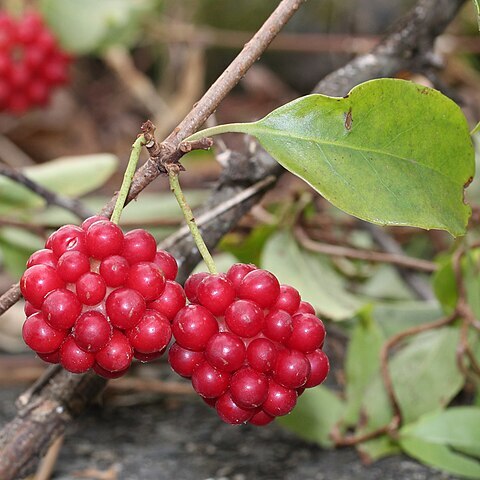Woody lianes, monoecious. Leaves alternate, exstipulate; lamina papyraceous to coriaceous, elliptic to ovate, apex acute or acuminate, base cuneate (especially when young), obtuse, truncate or subcordate, margins denticulate to entire, venation pinnate, brochido-dromous; petioles with groove on adaxial surface. Flowers unisexual, in axils of leaves or fugaceous bracts, generally solitary, occasionally with secondary flower growing in axil of prophyll, or in clusters of 2-4 growing from glomerules, occasionally cauliflorous. Perianth segments 7-24, imbricate at anthesis, outermost and innermost segments ± reduced, suborbicular, elliptic or ovate, rarely obovate, white, cream, yellow, pink or red, outer segments often green. Androecium of numerous (13-80) stamens; stamens sometimes ± free but connate at base of filaments and occasionally with several subulate appendages attached to distal apex of receptacle, stamens sometimes aggregated into subglobose head with connectives either broader than thick with thecae of adjacent stamens contiguous, or else with connective as broad as thick with thecae of adjacent stamens not contiguous; pollen grains hexacolpate, distally syncolpate. Gynoecium of numerous (17-c. 300) carpels; receptacle obovoid or subclavate or ellipsoid, only slightly longer than broad; stigmatic crest forming subulate or laterally flattened 'pseudostyle', or modified as subpeltate or irregular 'pseudostigma'; ovary with 2—5(—11) pendulous or ventrally attached ovules. Fruit a subglobose aggregate of berries attached to ellipsoid or clavate receptacle; berries subglobose to obovoid or elongate-obovoid, ripening red or yellow; peduncle often enlarged in fruit. Seeds 1-5, smooth, hilum lateral or apical. Fig. 1.
More
Vines, woody, glabrous (except Kadsura induta), dioecious or monoecious. Leaf blade elliptic, ovate, or obovate, papery to leathery, base cuneate (especially when young), broadly cuneate, truncate, or subcordate, margin denticulate to entire, apex acute to acuminate. Flowers unisexual, in axils of leaves or fugacious bracts or occasionally cauliflorous, generally solitary or sometimes in clusters of 2-4. Tepals 7-24. Staminate flowers: stamens 13-80, ± distinct but basally connate or sometimes tightly aggregated into a subglobose mass; pollen 6-colpate, distally syncolpate. Pistillate flowers: carpels 17 to ca. 300, distinct; stigmatic crest forming subulate or laterally flattened "pseudostyle" or modified as subpeltate or irregular "pseudostigma"; ovary with 1-5(-11) pendulous or ventrally attached ovules. Fruit aggregates of apocarps; receptacle ellipsoid or clavate; apocarps ripening red or yellow, subglobose, obovoid, or elongate-obovoid. Seeds 1-5(-11) per apocarp, smooth.
UsesKadsura is of little economic value, although K scandens (Blume) Blume is used for various medicinal purposes and produces edible fruits (discussed under the species, below).

